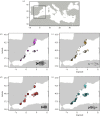Restricted dispersal in a sea of gene flow
- PMID: 34004134
- PMCID: PMC8131118
- DOI: 10.1098/rspb.2021.0458
Restricted dispersal in a sea of gene flow
Abstract
How far do marine larvae disperse in the ocean? Decades of population genetic studies have revealed generally low levels of genetic structure at large spatial scales (hundreds of kilometres). Yet this result, typically based on discrete sampling designs, does not necessarily imply extensive dispersal. Here, we adopt a continuous sampling strategy along 950 km of coast in the northwestern Mediterranean Sea to address this question in four species. In line with expectations, we observe weak genetic structure at a large spatial scale. Nevertheless, our continuous sampling strategy uncovers a pattern of isolation by distance at small spatial scales (few tens of kilometres) in two species. Individual-based simulations indicate that this signal is an expected signature of restricted dispersal. At the other extreme of the connectivity spectrum, two pairs of individuals that are closely related genetically were found more than 290 km apart, indicating long-distance dispersal. Such a combination of restricted dispersal with rare long-distance dispersal events is supported by a high-resolution biophysical model of larval dispersal in the study area, and we posit that it may be common in marine species. Our results bridge population genetic studies with direct dispersal studies and have implications for the design of marine reserve networks.
Keywords: dispersal; gene flow; isolation by distance; marine reserves; relatedness.
Figures




References
-
- Magris RA, Andrello M, Pressey RL, Mouillot D, Dalongeville A, Jacobi MN, Manel S. 2018. Biologically representative and well-connected marine reserves enhance biodiversity persistence in conservation planning. Conserv. Lett. 11, e12439. (10.1111/conl.12439) - DOI
Publication types
MeSH terms
Associated data
LinkOut - more resources
Full Text Sources
Other Literature Sources

